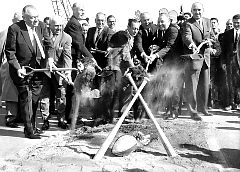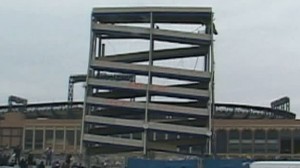On October 28, 1961, eight dignitaries in suits — including Mayor Bob Wagner, master builder Bob Moses [1] and future villain Don Grant — plunged spades into the ground and touched off the beginning of construction on a project tentatively titled Flushing Meadow(s) Stadium. It took 902 days to get from ceremonial shovels to the first official pitch thrown on that site, one fired by Jack Fisher of the New York Mets to Ducky Schofield of the Pittsburgh Pirates. By then, April 17, 1964 [2], the structure in question would be called Shea Stadium…and the pitch from Fisher would be called a strike by home plate umpire Tom Gorman. [3]
[3]
On September 28, 2008, Ryan Church would lift a deep fly ball to centerfield in the same place. Deep, but not deep enough. Cameron Maybin caught it and, in essence, ended the life of the stadium. A ballpark can’t be a ballpark unless it’s got some ball in it, and dratted Maybin made off with the last one [4]. Nevertheless, Shea stuck around after the final out, first for another ceremony — one in which Fisher, followed by 42 other former Mets, would bid adieu [5] to the stadium’s last assemblage — and then for the gruesome business of the building’s disassembly.
Breeze Demolition, a subcontractor from Red Hook, dug its hooks into Shea Stadium within hours of Fisher’s fond farewell. It took 143 days to pull apart what required 902 days to put together. For those of us who couldn’t help but monitor its methodical deconstruction, it seemed like it took forever for Shea to come down, yet in actuality, erasing it took less than one-sixth the time it took to create it.
 [6]The disappearance of Shea from the New York cityscape, save for the dust and debris that would linger into May, was completed just over a year ago, when on the morning of February 18, 2009 [7], the last immediately discernible sign of its existence vanished from the Queens skyline. Save for four brass bases and an accurately [8] if curiously named pitcher’s plate in a parking lot [9], it’s now like Shea Stadium was never there.
[6]The disappearance of Shea from the New York cityscape, save for the dust and debris that would linger into May, was completed just over a year ago, when on the morning of February 18, 2009 [7], the last immediately discernible sign of its existence vanished from the Queens skyline. Save for four brass bases and an accurately [8] if curiously named pitcher’s plate in a parking lot [9], it’s now like Shea Stadium was never there.
Shea, of course, lives on anyway. It lives on in our memories, our souls, our imaginations [10] and our Mets fan DNA. It also, thankfully, continues to exist in print, most notably in the pages of several recent and terrific books. One of them — Bottom of the Ninth [11] by Michael Shapiro — tells thoroughly if almost incidentally of Shea’s conception as part of a larger story of baseball’s late ’50s and early ’60s evolution. Two others whose reach is closer to home — Dana Brand’s The Last Days of Shea [12] and Shea Good-Bye [13] by Keith Hernandez and Matthew Silverman — offer loving encomia crafted on the eve of the park’s passing. Each of them is a worthy companion to the way you remember Shea, whether from its beginning, its middle or its end.
I’ve only recently gotten automatically used to the idea that there is no longer a Shea Stadium. No wonder: 2010 is the first calendar year in 50 during which there has been no immediately discernible sign of Shea Stadium. Still, the slow realization that it’s not around and that it’s not coming back goes beyond the longevity of an entity that began to stir in 1961 and ceased to exist in 2009. It goes beyond what Brand’s textured eloquence or Shapiro’s fresh history or Silverman’s expert editing of Hernandez’s occasionally random recollections can capture, too. It’s gets to the simple fact that Shea Stadium was my idea of what a ballpark was. It couldn’t help but be. It was my first ballpark.
It was my first park on TV. It was my first park in person. It was the park that defined what it meant to watch baseball for me. Shea shaded my view of every other park I’d ever visit, particularly the one I now technically call home.
I’ve been lucky enough to have attended Major League Baseball games in 34 different parks, 10 of which, like Shea, have either left the face of the earth or have stopped functioning in the MLB realm. On some level, that means I’ve been to…
• Shea Stadium;
• 9 parks that weren’t Shea Stadium;
• and 24 parks that are not Shea Stadium.
It won’t surprise you a bit that Shea defines my perspective on ballparks. It may surprise you, however, to learn I don’t consider Shea my favorite ballpark. Most beloved [14] and most resonant [15] to me, absolutely. But there are some I hold in what I guess you’d call higher esteem.
Oh, there’s none I hold as dear as Shea, but I’ve got the ability to delineate. I know when I’ve been somewhere that’s…I don’t know if “better” is the word I would use here, but I’ve been to parks that transcended Shea for me — which is no small feat [16]. That’s the litmus test I wound up applying once I began visiting other parks and ranking them. If I really felt that, all things being equal (though all things rarely are), I was having a Shea-plus time at a ballgame elsewhere, I had to be honest with myself. I had to say, y’know what? I have to rank this place ahead of Shea.
Not many ballparks made it over that hurdle. The uninitiated — anybody’s who’s not a Mets fan, probably — would not get that. But I imagine most of you who are Mets fans do.
Over the next several months, I plan to devote Flashback Friday to ballpark talk in a series ambitiously dubbed Take Me Out to 34 Ballparks. Starting Friday, March 5, I will revisit my 34th-favorite ballpark. The week after, we’ll go to my 33rd-favorite ballpark. Then…well, you get the idea. It’s a countdown because I like to count things down, but it’s less about my immensely subjective rankings than a chance for me to explore with you what these places mean to us as baseball fans.
It’s also an attempt on my part to place Citi Field in some kind of context besides it not being what Pedro Martinez memorably called my beloved Shea [17]. With Shea Stadium off the map, I hope to begin to view Citi Field apart from the ghost hovering over its third base shoulder. Figuring out where it stands for me is an unfinished assignment. Take Me Out to 34 Ballparks might provide me with some guidance.
I tend to rank my ballparks as soon as I see them. Most of them I’ve seen only once, and I know I’ll likely never see again. Citi Field is different in that respect. I didn’t rank it right away. In fact, I kept it unranked until I’d finished a full season there, and even now I view its status as provisional. I have a hunch Citi Field will always be a work in progress for me, which is fine. Shea was always going to be the static standard by which I measured every other ballpark. Citi’s place in my head (and maybe, eventually, my heart) can’t help but be more dynamic. My thoughts on it will be more subject to change than the other 33 parks combined.
But it does have a ranking, so it will show up where it shows up — same for Shea, same for the other 32 where I’ve been fortunate enough to experience big league baseball.
I like some parks more than I like other parks. It’s no secret that I like Shea more than I like Citi. But (again with all things being equal) I’d take being in a ballpark — any ballpark — over being anywhere else just about any day. So I’m pretty excited about going to one every Friday for the next 34 Fridays.
I hope you’ll find it a worthwhile trip.
Unless you’re soaking up the pleasures of practice fields in Florida or Arizona this weekend, consider spending an inning of more at the 24 Hour Talk-a-Thon to benefit Operation Homefront, a joint production of Baseball Digest, FantasyPros911.com and BlogTalkRadio.com. Details on this impressive undertaking for a worthy cause here [18].